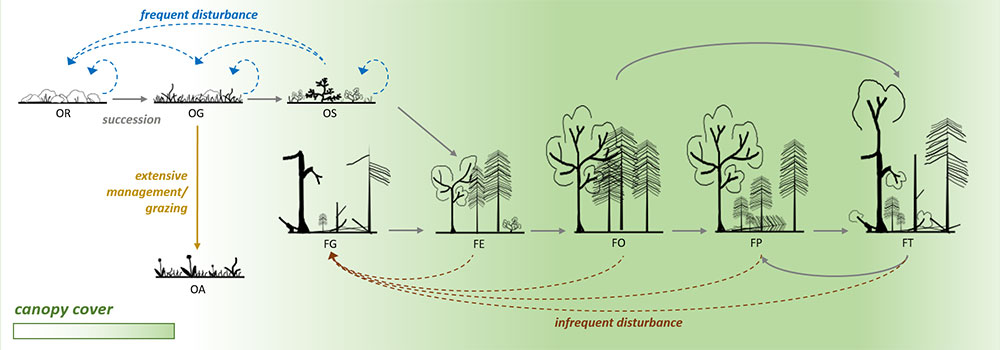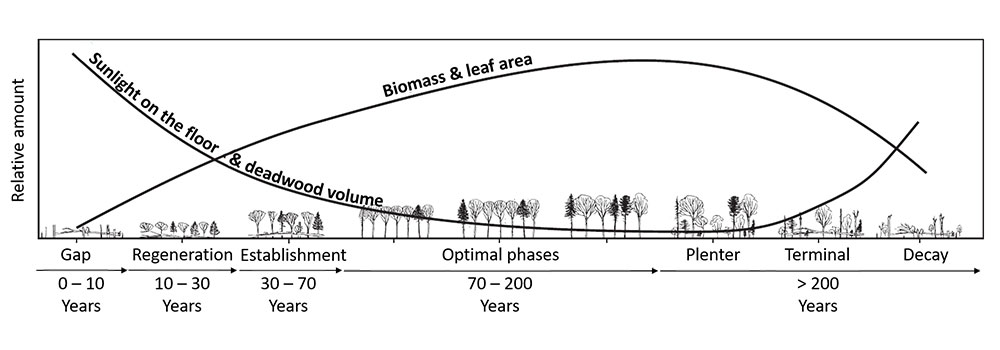Habitat transitions and succession
Habitats are constantly changing and with them their species communities and ecosystem processes. These changes are influenced by natural and anthropogenic disturbances and increasingly by climate change. To better assess ecosystem changes and make recommendations for sustainable management, a fundamental understanding of changes in species communities and ecosystem processes within and between different habitats is needed.

Overview of the types of study areas, their openness character (degree of canopy cover) and development opportunities determined by natural succession (solid lines), and type and frequency of disturbance (dashed lines). While the open land areas (rock-dominated (OR), grass-dominated (OG), woody-dominated (OS), anthropogenic/alpine (OA)) have at most a very low canopy cover (OB only), in the forest there is a gradient of areas with strongly open (gap (FG), closing phase (FT)), patchy (establishment phase (FE), plenter phase (FP)) and closed canopy (optimal phase (FO)). More detailed information and images on the recording methods/devices can be found on the pages on climate gradients and biodiversity monitoring. Graphic: Lisa Geres.
National parks offer the unique opportunity to explore natural habitat development over a large area. This habitat development, also called succession, can take place in very different temporal and structural forms. In order to better understand this process, a network of 213 study sites has been established in the Berchtesgaden National Park, which represents an age or development gradient of all typical habitats of the forest and open land there. Thus, in the forest, the spectrum ranges from young and open stands, such as those created by bark beetles or windthrow, to dense, medium-aged stands with a closed canopy, to stands with old and thick trees that gradually die and reopen the canopy. In the open country, rock-, grass-, and woody-dominated areas were selected in locations where forest cannot establish due to regular disturbance (e.g., avalanches) or elevation. In addition, study sites will be established on alpine pastures to include anthropogenically influenced openland habitats.
The development phases differ in their structure, vegetation, amount of deadwood, light availability, climate, and much more, which consequently leads to altered species compositions and ecosystem processes (e.g. nutrient cycling, CO2 storage). In collaboration with the Chair of Ecosystem Dynamics and Forest Management in Mountain Landscapes at the Technical University of Munich, the Department of Conservation Biology at the Goethe University Frankfurt, and the Bavarian Forest National Park, we are investigating how species communities and ecosystem processes change across and within different forest and openland habitats and what role natural and anthropogenic disturbances play in this process. A wide range of species groups are included, beginning with bacteria and fungi, through plants, insects, to birds, bats, and other vertebrates. The aim is to better predict changes in ecosystems and to derive recommendations for sustainable and biodiversity-promoting management practices from the findings. Another project deals with changes along the altitudinal gradient (600 to 2300 m a.s.l.) in order to better assess effects of climate warming. Part of the study areas will subsequently be transferred to long-term biodiversity monitoring.

Change in resource availability along the natural forest development. It should be noted that the decay phase can also occur earlier due to disturbances. Graphic adapted from Hilmers et al. (2018) Biodiversity along temperate forest succession.